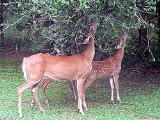
Herbivore
Overview
Herbivores are organisms that are anatomically and physiologically adapted to eat plant-based foods. Herbivory is a form of consumption
in which an organism
principally eats
autotroph
s such as plant
s, algae
and photosynthesizing bacteria
. More generally, organisms that feed on autotroph
s in general are known as primary consumers. Comes from the Greek
suffix "vora" (Greek -βόρα) meaning "which eat".
Herbivory usually refers to animals eating plants; fungi, bacteria and protists that feed on living plants are usually termed plant pathogens
(plant diseases),and microbes that feed on dead plants are saprotrophs.
Heterotroph
A heterotroph is an organism that cannot fix carbon and uses organic carbon for growth. This contrasts with autotrophs, such as plants and algae, which can use energy from sunlight or inorganic compounds to produce organic compounds such as carbohydrates, fats, and proteins from inorganic carbon...
in which an organism
Organism
In biology, an organism is any contiguous living system . In at least some form, all organisms are capable of response to stimuli, reproduction, growth and development, and maintenance of homoeostasis as a stable whole.An organism may either be unicellular or, as in the case of humans, comprise...
principally eats
Eating
Eating is the ingestion of food to provide for all organisms their nutritional needs, particularly for energy and growth. Animals and other heterotrophs must eat in order to survive: carnivores eat other animals, herbivores eat plants, omnivores consume a mixture of both plant and animal matter,...
autotroph
Autotroph
An autotroph, or producer, is an organism that produces complex organic compounds from simple inorganic molecules using energy from light or inorganic chemical reactions . They are the producers in a food chain, such as plants on land or algae in water...
s such as plant
Plant
Plants are living organisms belonging to the kingdom Plantae. Precise definitions of the kingdom vary, but as the term is used here, plants include familiar organisms such as trees, flowers, herbs, bushes, grasses, vines, ferns, mosses, and green algae. The group is also called green plants or...
s, algae
Algae
Algae are a large and diverse group of simple, typically autotrophic organisms, ranging from unicellular to multicellular forms, such as the giant kelps that grow to 65 meters in length. They are photosynthetic like plants, and "simple" because their tissues are not organized into the many...
and photosynthesizing bacteria
Bacteria
Bacteria are a large domain of prokaryotic microorganisms. Typically a few micrometres in length, bacteria have a wide range of shapes, ranging from spheres to rods and spirals...
. More generally, organisms that feed on autotroph
Autotroph
An autotroph, or producer, is an organism that produces complex organic compounds from simple inorganic molecules using energy from light or inorganic chemical reactions . They are the producers in a food chain, such as plants on land or algae in water...
s in general are known as primary consumers. Comes from the Greek
Greek language
Greek is an independent branch of the Indo-European family of languages. Native to the southern Balkans, it has the longest documented history of any Indo-European language, spanning 34 centuries of written records. Its writing system has been the Greek alphabet for the majority of its history;...
suffix "vora" (Greek -βόρα) meaning "which eat".
Herbivory usually refers to animals eating plants; fungi, bacteria and protists that feed on living plants are usually termed plant pathogens
Phytopathology
Plant pathology is the scientific study of plant diseases caused by pathogens and environmental conditions . Organisms that cause infectious disease include fungi, oomycetes, bacteria, viruses, viroids, virus-like organisms, phytoplasmas, protozoa, nematodes and parasitic plants...
(plant diseases),and microbes that feed on dead plants are saprotrophs.
Unanswered Questions

